Olympus E-620 vs Panasonic L10
The Olympus E-620 and the Panasonic Lumix DMC- L10 are two digital cameras that were revealed to the public, respectively, in February 2009 and August 2007. Both are DSLR (Digital Single Lens Reflex) cameras that are equipped with a Four Thirds sensor. The Olympus has a resolution of 12.2 megapixels, whereas the Panasonic provides 10 MP.
Below is an overview of the main specs of the two cameras as a starting point for the comparison.

Check E-620 offers at
ebay.com

Check L10 offers at
ebay.com
Going beyond this snapshot of core features and characteristics, what are the differences between the Olympus E-620 and the Panasonic Lumix DMC- L10? Which one should you buy? Read on to find out how these two cameras compare with respect to their body size, their imaging sensors, their shooting features, their input-output connections, and their reception by expert reviewers.
Body comparison
The side-by-side display below illustrates the physical size and weight of the Olympus E-620 and the Panasonic L10. The two cameras are presented according to their relative size. Three consecutive views from the front, the top, and the rear side are shown. All width, height and depth dimensions are rounded to the nearest millimeter.
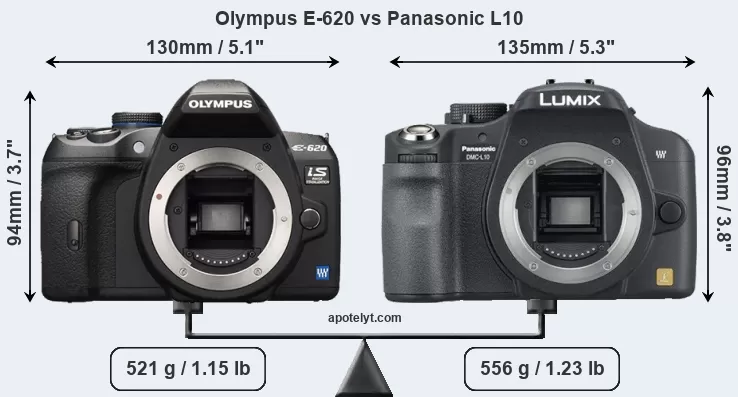
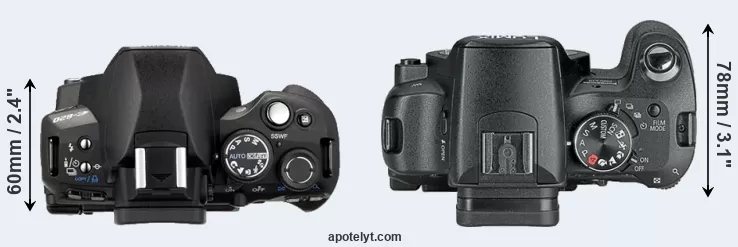
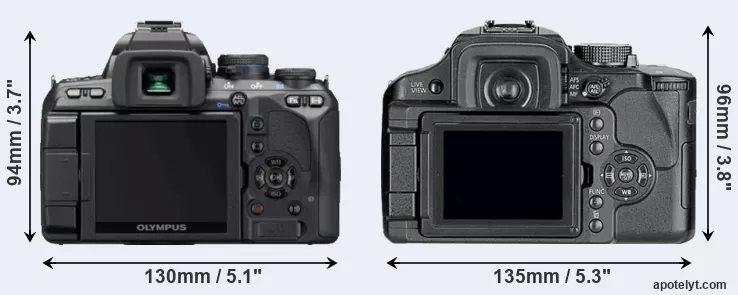
If the front view area (width x height) of the cameras is taken as an aggregate measure of their size, the Panasonic L10 is notably larger (6 percent) than the Olympus E-620. Moreover, the L10 is markedly heavier (7 percent) than the E-620. In this context, it is worth noting that neither the E-620 nor the L10 are weather-sealed.
The above size and weight comparisons are to some extent incomplete since they do not consider the interchangeable lenses that both of these cameras require. In this particular case, both cameras feature the same lens mount, so that they can use the same lenses. You can compare the optics available in the Four Thirds Lens Catalog.
The table below summarizes the key physical specs of the two cameras alongside a broader set of comparators. In case you want to display and compare another camera duo, you can use the CAM-parator app to select your camera combination among a large number of options.

| Camera Model |
Camera Width |
Camera Height |
Camera Depth |
Camera Weight |
Battery Life |
Weather Sealing |
Camera Launch |
Launch Price |
Street Price |
||
|---|---|---|---|---|---|---|---|---|---|---|---|
| 1. | Olympus E-620 | 130 mm | 94 mm | 60 mm | 521 g | 500 | n | Feb 2009 | US$ 699 | ebay.com | |
| 2. | Panasonic L10 | 135 mm | 96 mm | 78 mm | 556 g | 450 | n | Aug 2007 | US$ 599 | ebay.com | |
| 3. | Olympus E-30 | 142 mm | 108 mm | 75 mm | 701 g | 750 | n | Nov 2008 | US$ 1 299 | ebay.com | |
| 4. | Olympus E-410 | 130 mm | 91 mm | 53 mm | 435 g | 500 | n | Mar 2007 | US$ 699 | ebay.com | |
| 5. | Olympus E-420 | 130 mm | 91 mm | 53 mm | 440 g | 500 | n | Mar 2008 | US$ 599 | ebay.com | |
| 6. | Olympus E-450 | 130 mm | 91 mm | 53 mm | 440 g | 500 | n | Mar 2009 | US$ 499 | ebay.com | |
| 7. | Olympus E-510 | 136 mm | 92 mm | 68 mm | 538 g | 750 | n | Mar 2007 | US$ 799 | ebay.com | |
| 8. | Olympus E-520 | 136 mm | 92 mm | 68 mm | 535 g | 750 | n | May 2008 | US$ 699 | ebay.com | |
| 9. | Olympus E-600 | 130 mm | 94 mm | 60 mm | 535 g | 500 | n | Aug 2009 | US$ 449 | ebay.com | |
| 10. | Olympus E-P1 | 121 mm | 70 mm | 36 mm | 355 g | 300 | n | Jun 2009 | US$ 799 | ebay.com | |
| 11. | Olympus E-P2 | 121 mm | 70 mm | 36 mm | 355 g | 300 | n | Nov 2009 | US$ 799 | ebay.com | |
| 12. | Olympus E-PL1 | 115 mm | 72 mm | 42 mm | 334 g | 290 | n | Feb 2010 | US$ 599 | ebay.com | |
| 13. | Panasonic G10 | 124 mm | 84 mm | 74 mm | 388 g | 380 | n | Mar 2010 | US$ 499 | ebay.com | |
| 14. | Panasonic L1 | 146 mm | 87 mm | 64 mm | 606 g | 750 | n | Feb 2006 | US$ 999 | ebay.com | |
| Note: Measurements and pricing do not include easily detachable parts, such as add-on or interchangeable lenses or optional viewfinders. | |||||||||||
Any camera decision will obviously take relative prices into account. The listed launch prices provide an indication of the market segment that the manufacturer of the cameras have been targeting. The L10 was launched at a somewhat lower price (by 14 percent) than the E-620, which makes it more attractive for photographers on a tight budget. Usually, retail prices stay at first close to the launch price, but after several months, discounts become available. Later in the product cycle and, in particular, when the replacement model is about to appear, further discounting and stock clearance sales often push the camera price considerably down. Then, after the new model is out, very good deals can frequently be found on the pre-owned market.
Sensor comparison
The size of the imaging sensor is a crucial determinant of image quality. All other things equal, a large sensor will have larger individual pixel-units that offer better low-light sensitivity, wider dynamic range, and richer color-depth than smaller pixels in a sensor of the same technological generation. Further, a large sensor camera will give the photographer additional creative options when using shallow depth-of-field to isolate a subject from its background. On the downside, larger sensors are more costly to manufacture and tend to lead to bigger and heavier cameras and lenses.
Both cameras under consideration feature a Four Thirds sensor and have a format factor (sometimes also referred to as "crop factor") of 2.0. Within the spectrum of camera sensors, this places the review cameras among the medium-sized sensor cameras that aim to strike a balance between image quality and portability. Both cameras feature a native aspect ratio (sensor width to sensor height) of 4:3.
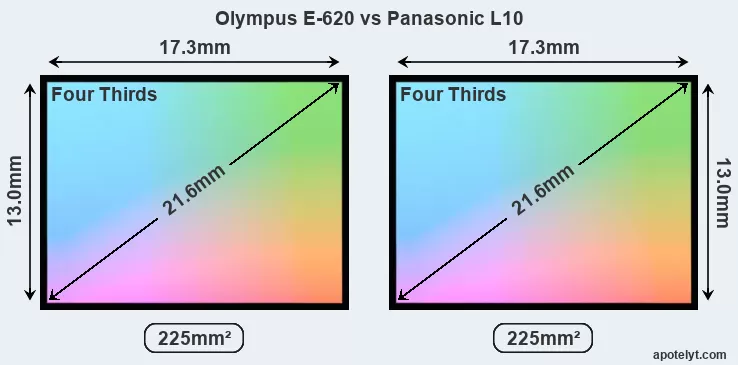
While the two cameras under review share the same sensor size, the E-620 offers a higher resolution of 12.2 megapixels, compared with 10 MP of the L10. This megapixels advantage translates into a 11 percent gain in linear resolution. On the other hand, these sensor specs imply that the E-620 has a higher pixel density and a smaller size of the individual pixel (with a pixel pitch of 4.29μm versus 4.74μm for the L10). In this context, it should be noted, however, that the E-620 is a somewhat more recent model (by 1 year and 5 months) than the L10, and its sensor might have benefitted from technological advances during this time that at least partly compensate for the smaller pixel size.
The resolution advantage of the Olympus E-620 implies greater flexibility for cropping images or the possibility to print larger pictures. The maximum print size of the E-620 for good quality output (200 dots per inch) amounts to 20.2 x 15.1 inches or 51.2 x 38.4 cm, for very good quality (250 dpi) 16.1 x 12.1 inches or 41 x 30.7 cm, and for excellent quality (300 dpi) 13.4 x 10.1 inches or 34.1 x 25.6 cm. The corresponding values for the Panasonic L10 are 18.2 x 13.7 inches or 46.3 x 34.7 cm for good quality, 14.6 x 10.9 inches or 37.1 x 27.8 cm for very good quality, and 12.2 x 9.1 inches or 30.9 x 23.2 cm for excellent quality prints.
The Olympus E-620 has a native sensitivity range from ISO 100 to ISO 3200. The corresponding ISO settings for the Panasonic Lumix DMC- L10 are ISO 100 to ISO 1600 (no boost).
Technology-wise, both cameras are equipped with CMOS (Complementary Metal–Oxide–Semiconductor) sensors. Both cameras use a Bayer filter for capturing RGB colors on a square grid of photosensors. This arrangement is found in most digital cameras.
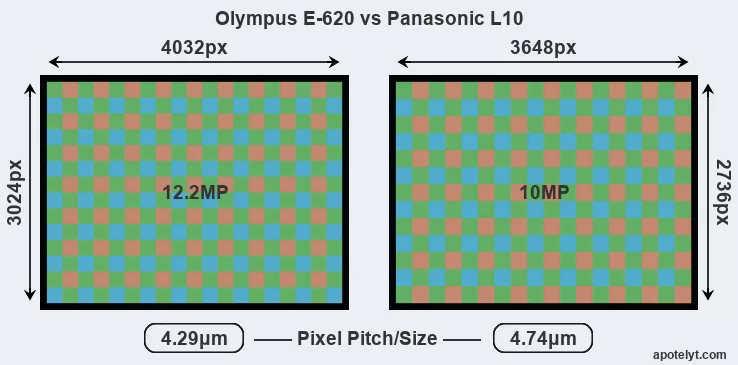
For many cameras, data on sensor performance has been reported by DXO Mark. This service determines an overall sensor rating, as well as sub-scores for low-light sensitivity ("DXO Sports"), dynamic range ("DXO Landscape"), and color depth ("DXO Portrait"). The Overall DXO ratings for the two cameras under consideration are close, suggesting that they provide similar imaging performance. The adjacent table reports on the physical sensor characteristics and the outcomes of the DXO sensor quality tests for a sample of comparator-cameras.

| Camera Model |
Sensor Class |
Resolution (MP) |
Horiz. Pixels |
Vert. Pixels |
Video Format |
DXO Portrait |
DXO Landscape |
DXO Sports |
DXO Overall |
||
|---|---|---|---|---|---|---|---|---|---|---|---|
| 1. | Olympus E-620 | Four Thirds | 12.2 | 4032 | 3024 | none | 21.3 | 10.3 | 536 | 55 | |
| 2. | Panasonic L10 | Four Thirds | 10.0 | 3648 | 2736 | none | 21.3 | 10.8 | 429 | 55 | |
| 3. | Olympus E-30 | Four Thirds | 12.2 | 4032 | 3024 | none | 21.3 | 10.4 | 530 | 55 | |
| 4. | Olympus E-410 | Four Thirds | 10.0 | 3648 | 2736 | none | 21.1 | 10.0 | 494 | 51 | |
| 5. | Olympus E-420 | Four Thirds | 10.0 | 3648 | 2736 | none | 21.5 | 10.4 | 527 | 56 | |
| 6. | Olympus E-450 | Four Thirds | 10.0 | 3648 | 2736 | none | 21.5 | 10.5 | 512 | 56 | |
| 7. | Olympus E-510 | Four Thirds | 10.0 | 3648 | 2736 | none | 21.2 | 10.0 | 442 | 52 | |
| 8. | Olympus E-520 | Four Thirds | 10.0 | 3648 | 2736 | none | 21.4 | 10.4 | 548 | 55 | |
| 9. | Olympus E-600 | Four Thirds | 12.2 | 4032 | 3024 | none | 21.5 | 10.3 | 541 | 55 | |
| 10. | Olympus E-P1 | Four Thirds | 12.2 | 4032 | 3024 | 720/30p | 21.4 | 10.4 | 536 | 55 | |
| 11. | Olympus E-P2 | Four Thirds | 12.2 | 4032 | 3024 | 720/30p | 21.5 | 10.4 | 505 | 56 | |
| 12. | Olympus E-PL1 | Four Thirds | 12.2 | 4032 | 3024 | 720/30p | 21.5 | 10.1 | 487 | 54 | |
| 13. | Panasonic G10 | Four Thirds | 12.0 | 4000 | 3000 | 720/30p | 21.2 | 10.1 | 411 | 52 | |
| 14. | Panasonic L1 | Four Thirds | 7.4 | 3136 | 2352 | none | 20.8 | 10.4 | 80 | 52 | |
| Note: DXO values in italics represent estimates based on sensor size and age. | |||||||||||
Feature comparison
Apart from body and sensor, cameras can and do differ across a range of features. The E-620 and the L10 are similar in the sense that both have an optical viewfinder. The latter is useful for getting a clear image for framing even in brightly lit environments. The viewfinders of both cameras offer the same field of view (95%), but the viewfinder of the E-620 has a higher magnification than the one of the L10 (0.48x vs 0.46x), so that the size of the image transmitted appears closer to the size seen with the naked human eye. The adjacent table lists some of the other core features of the Olympus E-620 and Panasonic L10 along with similar information for a selection of comparators.

| Camera Model |
Viewfinder (Type or 000 dots) |
Control Panel (yes/no) |
LCD Specifications (inch/000 dots) |
LCD Attach- ment |
Touch Screen (yes/no) |
Max Shutter Speed * |
Max Shutter Flaps * |
Built-in Flash (yes/no) |
Built-in Image Stab |
||
|---|---|---|---|---|---|---|---|---|---|---|---|
| 1. | Olympus E-620 | optical | n | 2.7 / 230 | swivel | n | 1/4000s | 4.0/s | Y | Y | |
| 2. | Panasonic L10 | optical | n | 2.5 / 207 | swivel | n | 1/4000s | 3.0/s | Y | n | |
| 3. | Olympus E-30 | optical | Y | 2.7 / 230 | swivel | n | 1/8000s | 5.0/s | Y | Y | |
| 4. | Olympus E-410 | optical | n | 2.5 / 215 | fixed | n | 1/4000s | 3.0/s | Y | n | |
| 5. | Olympus E-420 | optical | n | 2.7 / 215 | fixed | n | 1/4000s | 3.5/s | Y | n | |
| 6. | Olympus E-450 | optical | n | 2.7 / 215 | fixed | n | 1/4000s | 3.5/s | Y | n | |
| 7. | Olympus E-510 | optical | n | 2.5 / 215 | fixed | n | 1/4000s | 3.0/s | Y | Y | |
| 8. | Olympus E-520 | optical | n | 2.7 / 215 | fixed | n | 1/4000s | 3.5/s | Y | Y | |
| 9. | Olympus E-600 | optical | n | 2.7 / 230 | swivel | n | 1/4000s | 4.0/s | Y | Y | |
| 10. | Olympus E-P1 | none | n | 3.0 / 230 | fixed | n | 1/4000s | 3.0/s | n | Y | |
| 11. | Olympus E-P2 | optional | n | 3.0 / 230 | fixed | n | 1/4000s | 3.0/s | n | Y | |
| 12. | Olympus E-PL1 | optional | n | 2.7 / 230 | fixed | n | 1/2000s | 3.0/s | Y | Y | |
| 13. | Panasonic G10 | 202 | n | 3.0 / 460 | fixed | n | 1/4000s | 2.6/s | Y | n | |
| 14. | Panasonic L1 | optical | n | 2.5 / 207 | fixed | n | 1/4000s | 3.0/s | Y | n | |
| Note: *) Information refers to the mechanical shutter, unless the camera only has an electronic one. | |||||||||||
One feature that differentiates the E-620 and the L10 is in-body image stabilization (IBIS). The E-620 reduces the risk of handshake-induced blur with all attached lenses, while the L10 offers no blur reduction with lenses that themselves do not provide optical image stabilization.
Both cameras have an articulated rear screen that can be turned to be front-facing. This feature will be particularly appreciated by vloggers and photographers who are interested in taking selfies.The E-620 writes its imaging data to Compact Flash or xD Picture cards, while the L10 uses SDHC cards. The E-620 features dual card slots, which can be very useful in case a memory card fails. In contrast, the L10 only has one slot.
Connectivity comparison
For some imaging applications, the extent to which a camera can communicate with its environment can be an important aspect in the camera decision process. The table below provides an overview of the connectivity of the Olympus E-620 and Panasonic Lumix DMC- L10 and, in particular, the interfaces the cameras (and selected comparators) provide for accessory control and data transfer.

| Camera Model |
Hotshoe Port |
Internal Mic / Speaker |
Microphone Port |
Headphone Port |
HDMI Port |
USB Port |
WiFi Support |
NFC Support |
Bluetooth Support |
||
|---|---|---|---|---|---|---|---|---|---|---|---|
| 1. | Olympus E-620 | Y | - / - | - | - | - | 2.0 | - | - | - | |
| 2. | Panasonic L10 | Y | - / - | - | - | - | 2.0 | - | - | - | |
| 3. | Olympus E-30 | Y | - / - | - | - | - | 2.0 | - | - | - | |
| 4. | Olympus E-410 | Y | - / - | - | - | - | 2.0 | - | - | - | |
| 5. | Olympus E-420 | Y | - / - | - | - | - | 2.0 | - | - | - | |
| 6. | Olympus E-450 | Y | - / - | - | - | - | 2.0 | - | - | - | |
| 7. | Olympus E-510 | Y | - / - | - | - | - | 2.0 | - | - | - | |
| 8. | Olympus E-520 | Y | - / - | - | - | - | 2.0 | - | - | - | |
| 9. | Olympus E-600 | Y | - / - | - | - | - | 2.0 | - | - | - | |
| 10. | Olympus E-P1 | Y | stereo / - | - | - | mini | 2.0 | - | - | - | |
| 11. | Olympus E-P2 | Y | stereo / - | - | - | mini | 2.0 | - | - | - | |
| 12. | Olympus E-PL1 | Y | stereo / - | - | - | mini | 2.0 | - | - | - | |
| 13. | Panasonic G10 | Y | mono / - | - | - | mini | 2.0 | - | - | - | |
| 14. | Panasonic L1 | Y | - / - | - | - | - | 2.0 | - | - | - |
Both the E-620 and the L10 have been discontinued, but can regularly be found used on ebay. The E-620 was replaced by the Olympus E-600, while the L10 does not have a direct successor. Further information on the features and operation of the E-620 and L10 can be found, respectively, in the Olympus E-620 Manual (free pdf) or the online Panasonic L10 Manual.
Review summary
So what conclusions can be drawn? Is the Olympus E-620 better than the Panasonic L10 or vice versa? Below is a summary of the relative strengths of each of the two contestants.

Arguments in favor of the Olympus E-620:
- More detail: Offers more megapixels (12.2 vs 10MP) with a 11% higher linear resolution.
- Larger viewfinder image: Features a viewfinder with a higher magnification (0.48x vs 0.46x).
- Larger screen: Has a bigger rear LCD (2.7" vs 2.5") for image review and settings control.
- More detailed LCD: Has a higher resolution rear screen (230k vs 207k dots).
- Faster burst: Shoots at higher frequency (4 vs 3 flaps/sec) to capture the decisive moment.
- Longer lasting: Can take more shots (500 versus 450) on a single battery charge.
- Sharper images: Has hand-shake reducing image stabilization built-in.
- Greater peace of mind: Features a second card slot as a backup in case of memory card failure.
- More modern: Is somewhat more recent (announced 1 year and 5 months after the L10).

Advantages of the Panasonic Lumix DMC- L10:
- More affordable: Was released into a lower priced segment (14 percent cheaper at launch).
- More heavily discounted: Has been on the market for longer (launched in August 2007).
If the number of relative strengths (bullet points above) is taken as a guide, the E-620 is the clear winner of the match-up (9 : 2 points). However, the pertinence of the various camera strengths will differ across photographers, so that you might want to weigh individual camera traits according to their importance for your own imaging needs before making a camera decision. A professional wildlife photographer will view the differences between cameras in a way that diverges from the perspective of a family photog, and a person interested in architecture has distinct needs from a sports shooter. Hence, the decision which camera is best and worth buying is often a very personal one.
How about other alternatives? Do the specifications of the Olympus E-620 and the Panasonic L10 place the cameras among the top in their class? Find out in the latest Best DSLR Camera listing whether the two cameras rank among the cream of the crop.
In any case, while the comparison of the spec-sheets of cameras can offer a general idea of their imaging potential, it remains partial and cannot reveal, for example, the shooting experience and imaging performance when actually working with the E-620 or the L10. User reviews, such as those found at amazon, can sometimes inform about these issues, but such feedback is often incomplete, inconsistent, and biased.
Expert reviews
This is why hands-on reviews by experts are important. The table below provides a synthesis of the camera assessments of some of the best known photo-gear review sites (amateurphotographer [AP], cameralabs [CL], digitalcameraworld [DCW], dpreview [DPR], ephotozine [EPZ], photographyblog [PB]). As can be seen, the professional reviewers agree in many cases on the quality of different cameras, but sometimes their assessments diverge, reinforcing the earlier point that a camera decision is often a very personal choice.

| Camera Model |
AP score |
CL score |
DCW score |
DPR score |
EPZ score |
PB score |
Camera Launch |
Launch Price |
Street Price |
||
|---|---|---|---|---|---|---|---|---|---|---|---|
| 1. | Olympus E-620 | 3/5 | 88/100 | .. | 72/100 | 4.5/5 | 5/5 | Feb 2009 | US$ 699 | ebay.com | |
| 2. | Panasonic L10 | .. | 85/100 | .. | + | 3.5/5 | 4/5 | Aug 2007 | US$ 599 | ebay.com | |
| 3. | Olympus E-30 | .. | .. | .. | 71/100 | 4.5/5 | 4/5 | Nov 2008 | US$ 1 299 | ebay.com | |
| 4. | Olympus E-410 | .. | 86/100 | .. | + + | 4/5 | 4.5/5 | Mar 2007 | US$ 699 | ebay.com | |
| 5. | Olympus E-420 | .. | 85/100 | .. | + + | 4/5 | 4.5/5 | Mar 2008 | US$ 599 | ebay.com | |
| 6. | Olympus E-450 | .. | .. | .. | .. | 4/5 | 4/5 | Mar 2009 | US$ 499 | ebay.com | |
| 7. | Olympus E-510 | .. | 89/100 | .. | + + | 3.5/5 | 4.5/5 | Mar 2007 | US$ 799 | ebay.com | |
| 8. | Olympus E-520 | .. | 87/100 | .. | + + | 4.5/5 | 4.5/5 | May 2008 | US$ 699 | ebay.com | |
| 9. | Olympus E-600 | .. | .. | .. | .. | .. | 4.5/5 | Aug 2009 | US$ 449 | ebay.com | |
| 10. | Olympus E-P1 | .. | + | .. | 66/100 | 4/5 | 4.5/5 | Jun 2009 | US$ 799 | ebay.com | |
| 11. | Olympus E-P2 | 3/5 | + | .. | 69/100 | 4/5 | 4.5/5 | Nov 2009 | US$ 799 | ebay.com | |
| 12. | Olympus E-PL1 | .. | 86/100 | .. | 69/100 | 4/5 | 4.5/5 | Feb 2010 | US$ 599 | ebay.com | |
| 13. | Panasonic G10 | 3/5 | .. | .. | 70/100 | 4/5 | 4/5 | Mar 2010 | US$ 499 | ebay.com | |
| 14. | Panasonic L1 | .. | 85/100 | .. | + | .. | 3.5/5 | Feb 2006 | US$ 999 | ebay.com | |
| Note: (+ +) highly recommended; (+) recommended; (o) reviewed; (..) not available. | |||||||||||
The above review scores should be interpreted with care, though. The assessments were made in relation to similar cameras of the same technological generation. Thus, a score needs to be put into the context of the launch date and the launch price of the camera, and comparisons of ratings among very different cameras or across long time periods have little meaning. Also, kindly note that some of the listed sites have over time developped their review approaches and their reporting style.

Check E-620 offers at
ebay.com

Check L10 offers at
ebay.com
Other camera comparisons
Did this review help to inform your camera decision process? If you would like to see a different side-by-side camera review, just make a corresponding selection in the search boxes below. As an alternative, you can also directly jump to any one of the listed comparisons that were previously generated by the CAM-parator tool.
- Canon 1Ds Mark II vs Panasonic L10
- Canon 1Ds vs Panasonic L10
- Canon 600D vs Panasonic L10
- Canon 60D vs Olympus E-620
- Canon 80D vs Olympus E-620
- Canon G3 X vs Panasonic L10
- Epson R-D1 vs Olympus E-620
- Hasselblad X1D II vs Olympus E-620
- Nikon D810 vs Olympus E-620
- Nikon Z6 II vs Olympus E-620
- Olympus E-500 vs Panasonic L10
- Panasonic GF3 vs Panasonic L10
Specifications: Olympus E-620 vs Panasonic L10
Below is a side-by-side comparison of the specs of the two cameras to facilitate a quick review of their differences and common features.
| Camera Model | Olympus E-620 | Panasonic L10 |
|---|---|---|
| Camera Type | Digital single lens reflex | Digital single lens reflex |
| Camera Lens | Four Thirds lenses | Four Thirds lenses |
| Launch Date | February 2009 | August 2007 |
| Launch Price | USD 699 | USD 599 |
| Sensor Specs | Olympus E-620 | Panasonic L10 |
| Sensor Technology | CMOS | CMOS |
| Sensor Format | Four Thirds Sensor | Four Thirds Sensor |
| Sensor Size | 17.3 x 13.0 mm | 17.3 x 13.0 mm |
| Sensor Area | 224.9 mm2 | 224.9 mm2 |
| Sensor Diagonal | 21.6 mm | 21.6 mm |
| Crop Factor | 2.0x | 2.0x |
| Sensor Resolution | 12.2 Megapixels | 10 Megapixels |
| Image Resolution | 4032 x 3024 pixels | 3648 x 2736 pixels |
| Pixel Pitch | 4.29 μm | 4.74 μm |
| Pixel Density | 5.42 MP/cm2 | 4.44 MP/cm2 |
| Moiré control | Anti-Alias filter | Anti-Alias filter |
| Movie Capability | no Video | no Video |
| ISO Setting | 100 - 3,200 ISO | 100 - 1,600 ISO |
| Image Processor | TruePic III+ | Venus |
| DXO Sensor Quality (score) | 55 | 55 |
| DXO Color Depth (bits) | 21.3 | 21.3 |
| DXO Dynamic Range (EV) | 10.3 | 10.8 |
| DXO Low Light (ISO) | 536 | 429 |
| Screen Specs | Olympus E-620 | Panasonic L10 |
| Viewfinder Type | Optical viewfinder | Optical viewfinder |
| Viewfinder Field of View | 95% | 95% |
| Viewfinder Magnification | 0.48x | 0.46x |
| LCD Framing | Live View | Live View |
| Rear LCD Size | 2.7inch | 2.5inch |
| LCD Resolution | 230k dots | 207k dots |
| LCD Attachment | Swivel screen | Swivel screen |
| Shooting Specs | Olympus E-620 | Panasonic L10 |
| Focus System | Phase-detect AF | Phase-detect AF |
| Continuous Shooting | 4 shutter flaps/s | 3 shutter flaps/s |
| Image Stabilization | In-body stabilization | Lens stabilization only |
| Fill Flash | Built-in Flash | Built-in Flash |
| Storage Medium | CF or XD cards | SDHC cards |
| Single or Dual Card Slots | Dual card slots | Single card slot |
| Connectivity Specs | Olympus E-620 | Panasonic L10 |
| External Flash | Hotshoe | Hotshoe |
| USB Connector | USB 2.0 | USB 2.0 |
| HDMI Port | no HDMI | no HDMI |
| Wifi Support | no Wifi | no Wifi |
| Body Specs | Olympus E-620 | Panasonic L10 |
| Battery Type | Olympus BLS-1 | Panasonic DMW-BLA13 |
| Battery Life (CIPA) | 500 shots per charge | 450 shots per charge |
| Body Dimensions |
130 x 94 x 60 mm (5.1 x 3.7 x 2.4 in) |
135 x 96 x 78 mm (5.3 x 3.8 x 3.1 in) |
| Camera Weight | 521 g (18.4 oz) | 556 g (19.6 oz) |

Check E-620 offers at
ebay.com

Check L10 offers at
ebay.com
Did you notice an error on this page? If so, please get in touch, so that we can correct the information.

